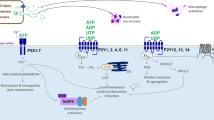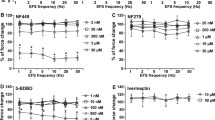Abstract
Purinergic signaling is a term that relates to adenosine triphosphate binding to its receptor (purinergic receptors such as P2X and P2Y subtypes). This pathway has been implicated in bladder functional disorders related to interstitial cystitis/painful bladder syndrome, neurogenic bladder secondary to spinal cord injury, lower urinary tract symptoms, diabetes, and aging. Purinergic signaling occurs at multiple sites, including the central nervous system, peripheral motor and sensory nerves, detrusor smooth muscle, and bladder urothelium. Future pharmacologic agents to treat bladder functional disorders may be able to target purinergic signaling at one or more of these sites.
Similar content being viewed by others
References
Papers of particular interest, published recently, have been highlighted as: • Of importance
Burnstock G, Campbell G, Satchell D, Smythe A: Evidence that adenosine triphosphate or a related nucleotide is the transmitter substance released by non-adrenergic inhibitory nerves in the gut. Br J Pharmacol 1970, 40:668–688.
Burnstock G: Purinergic signalling. Br J Pharmacol 2006, 147(Suppl 1):S172–S181.
Burnstock G: Purinergic mechanosensory transduction and visceral pain. Mol Pain 2009, 5:69.
Tsuda M, Tozaki-Saitoh H, Inoue K: Pain and purinergic signaling. Brain Res Rev 2010, 63:222–232.
Burnstock G: Potential therapeutic targets in the rapidly expanding field of purinergic signalling. Clin Med 2002, 2:45–53.
Cockayne DA, Hamilton SG, Zhu QM, et al.: Urinary bladder hyporeflexia and reduced pain-related behaviour in P2X3-deficient mice. Nature 2000, 407:1011–1015.
Cockayne DA, Dunn PM, Zhong Y, et al.: P2X2 knockout mice and P2X2/P2X3 double knockout mice reveal a role for the P2X2 receptor subunit in mediating multiple sensory effects of ATP. J Physiol 2005, 567:621–639.
Andersson KE: Overactive bladder—pharmacological aspects. Scand J Urol Nephrol Suppl 2002, 210:72–81.
Andersson KE, Hedlund P: Pharmacologic perspective on the physiology of the lower urinary tract. Urology 2002, 60(5 Suppl 1):13–20.
Ruggieri MR Sr: Mechanisms of disease: role of purinergic signaling in the pathophysiology of bladder dysfunction. Nat Clin Pract Urol 2006, 3:206–215.
Yoshimura N, Kaiho Y, Miyazato M, et al.: Therapeutic receptor targets for lower urinary tract dysfunction. Naunyn Schmiedebergs Arch Pharmacol 2008, 377:437–448.
Ford AP, Gever JR, Nunn PA, et al.: Purinoceptors as therapeutic targets for lower urinary tract dysfunction. Br J Pharmacol 2006, 147(Suppl 2):S132–S143.
Gur S, Kadowitz PJ, Hellstrom WJ: Purinergic (P2) receptor control of lower genitourinary tract function and new avenues for drug action: an overview. Curr Pharm Des 2007, 13:3236–3244.
de Groat WC: The urothelium in overactive bladder: passive bystander or active participant? Urology 2004, 64(6 Suppl 1):7–11.
Kanai A, de Groat W, Birder L, et al.: Symposium report on urothelial dysfunction: pathophysiology and novel therapies. J Urol 2006, 175:1624–1629.
Chopra B, Gever J, Barrick SR, et al.: Expression and function of rat urothelial P2Y receptors. Am J Physiol Renal Physiol 2008, 294:F821–F829.
Tempest HV, Dixon AK, Turner WH, et al.: P2X and P2X receptor expression in human bladder urothelium and changes in interstitial cystitis. BJU Int 2004, 93:1344–1348.
Wang EC, Lee JM, Ruiz WG, et al.: ATP and purinergic receptor-dependent membrane traffic in bladder umbrella cells. J Clin Invest 2005, 115:2412–2422.
Chai TC, Keay S: New theories in interstitial cystitis. Nat Clin Pract Urol 2004, 1:85–89.
Graham E, Chai TC: Dysfunction of bladder urothelium and bladder urothelial cells in interstitial cystitis. Curr Urol Rep 2006, 7:440–446.
Sun Y, Keay S, De Deyne PG, Chai TC: Augmented stretch activated adenosine triphosphate release from bladder uroepithelial cells in patients with interstitial cystitis. J Urol 2001, 166:1951–1956.
Sun Y, Chai TC: Up-regulation of P2X3 receptor during stretch of bladder urothelial cells from patients with interstitial cystitis. J Urol 2004, 171:448–452.
Birder LA, Barrick SR, Roppolo JR, et al.: Feline interstitial cystitis results in mechanical hypersensitivity and altered ATP release from bladder urothelium. Am J Physiol Renal Physiol 2003, 285:F423–F429.
Birder LA, Ruan HZ, Chopra B, et al.: Alterations in P2X and P2Y purinergic receptor expression in urinary bladder from normal cats and cats with interstitial cystitis. Am J Physiol Renal Physiol 2004, 287:F1084–F1091.
Sun Y, Chai TC: Augmented extracellular ATP signaling in bladder urothelial cells from patients with interstitial cystitis. Am J Physiol Cell Physiol 2006, 290:C27–C34.
Dang K, Lamb K, Cohen M, et al.: Cyclophosphamide-induced bladder inflammation sensitizes and enhances P2X receptor function in rat bladder sensory neurons. J Neurophysiol 2008, 99:49–59.
Ito K, Iwami A, Katsura H, Ikeda M: Therapeutic effects of the putative P2X3/P2X2/3 antagonist A-317491 on cyclophosphamide-induced cystitis in rats. Naunyn Schmiedebergs Arch Pharmacol 2008, 377:483–490.
Kageyama A, Fujino T, Taki Y, et al.: Alteration of muscarinic and purinergic receptors in urinary bladder of rats with cyclophosphamide-induced interstitial cystitis. Neurosci Lett 2008, 436:81–84.
Keay SK, Szekely Z, Conrads TP, et al.: An antiproliferative factor from interstitial cystitis patients is a frizzled 8 protein-related sialoglycopeptide. Proc Natl Acad Sci U S A 2004, 101:11803–11808.
Sun Y, Keay S, Lehrfeld TJ, Chai TC: Changes in adenosine triphosphate-stimulated ATP release suggest association between cytokine and purinergic signaling in bladder urothelial cells. Urology 2009, 74:1163–1168.
de Groat WC, Yoshimura N: Afferent nerve regulation of bladder function in health and disease. Handb Exp Pharmacol 2009, 194:91–138.
de Groat WC, Yoshimura N: Changes in afferent activity after spinal cord injury. Neurourol Urodyn 2010, 29:63–76.
Pannek J, Janek S, Sommerer F, Tannapfel A: Expression of purinergic P2X2-receptors in neurogenic bladder dysfunction due to spinal cord injury: a preliminary immunohistochemical study. Spinal Cord 2009, 47:561–564.
Lu SH, Groat WC, Lin AT, et al.: Evaluation of purinergic mechanism for the treatment of voiding dysfunction: a study in conscious spinal cord-injured rats. J Chin Med Assoc 2007, 70:439–444.
Yokota T, Yamaguchi O: Changes in cholinergic and purinergic neurotransmission in pathologic bladder of chronic spinal rabbit. J Urol 1996, 156:1862–1866.
Salas NA, Somogyi GT, Gangitano DA, et al.: Receptor activated bladder and spinal ATP release in neurally intact and chronic spinal cord injured rats. Neurochem Int 2007, 50:345–350.
Sperlágh B, Vizi ES, Wirkner K, Illes P: P2X7 receptors in the nervous system. Prog Neurobiol 2006, 78:327–346.
• Peng W, Cotrina ML, Han X, et al.: Systemic administration of an antagonist of the ATP-sensitive receptor P2X7 improves recovery after spinal cord injury. Proc Natl Acad Sci U S A 2009, 106:12489–12493. Although this article is not directly related to bladder function, it provides a foundation for innovative treatment of SCI. If one can limit the SCI after it occurs, or perhaps help healing with purinergic antagonists, perhaps one can also limit the degree of bladder dysfunction that arises as a result.
Wang X, Arcuino G, Takano T, et al.: P2X7 receptor inhibition improves recovery after spinal cord injury. Nat Med 2004, 10:821–827.
Studeny S, Torabi A, Vizzard MA: P2X2 and P2X3 receptor expression in postnatal and adult rat urinary bladder and lumbosacral spinal cord. Am J Physiol Regul Integr Comp Physiol 2005, 289:R1155–R1168.
Fields RD: Nerve impulses regulate myelination through purinergic signalling. Novartis Found Symp 2006, 276:148–158.
Khera M, Somogyi GT, Kiss S, et al.: Botulinum toxin A inhibits ATP release from bladder urothelium after chronic spinal cord injury. Neurochem Int 2004, 45:987–993.
Smith CP, Gangitano DA, Munoz A, et al.: Botulinum toxin type A normalizes alterations in urothelial ATP and NO release induced by chronic spinal cord injury. Neurochem Int 2008, 52:1068–1075.
Chancellor MB, Fowler CJ, Apostolidis A, et al.: Drug insight: biological effects of botulinum toxin A in the lower urinary tract. Nat Clin Pract Urol 2008, 5:319–328.
Bayliss M, Wu C, Newgreen D, et al.: A quantitative study of atropine-resistant contractile responses in human detrusor smooth muscle, from stable, unstable and obstructed bladders. J Urol 1999, 162:1833–1839.
Calvert RC, Thompson CS, Khan MA, et al.: Alterations in cholinergic and purinergic signaling in a model of the obstructed bladder. J Urol 2001, 166:1530–1533.
Pinna C, Sanvito P, Puglisi L: Altered neurogenic and mechanical responses to acetylcholine, ATP and substance P in detrusor from rat with outlet obstruction. Life Sci 2006, 79:1301–1306.
Banks FC, Knight GE, Calvert RC, et al.: Alterations in purinergic and cholinergic components of contractile responses of isolated detrusor contraction in a rat model of partial bladder outlet obstruction. BJU Int 2006, 97:372–378.
Scott RS, Uvelius B, Arner A: Changes in intracellular calcium concentration and P2X1 receptor expression in hypertrophic rat urinary bladder smooth muscle. Neurourol Urodyn 2004, 23:361–366.
Chua WC, Liu L, Mansfield KJ, et al.: Age-related changes of P2X(1) receptor mRNA in the bladder detrusor from men with and without bladder outlet obstruction. Exp Gerontol 2007, 42:686–692.
Kim JC, Yoo JS, Park EY, et al.: Muscarinic and purinergic receptor expression in the urothelium of rats with detrusor overactivity induced by bladder outlet obstruction. BJU Int 2008, 101:371–375.
Sun Y, MaLossi J, Jacobs SC, Chai TC: Effect of doxazosin on stretch-activated adenosine triphosphate release in bladder urothelial cells from patients with benign prostatic hyperplasia. Urology 2002, 60:351–356.
Velasco C, Guarneri L, Leonardi A, Testa R: Effects of intravenous and infravesical administration of suramin, terazosin and BMY 7378 on bladder instability in conscious rats with bladder outlet obstruction. BJU Int 2003, 92:131–136.
Sugaya K, Nishijima S, Kadekawa K, et al.: Relationship between lower urinary tract symptoms and urinary ATP in patients with benign prostatic hyperplasia or overactive bladder. Biomed Res 2009, 30:287–294.
Yoshida M, Miyamae K, Iwashita H, et al.: Management of detrusor dysfunction in the elderly: changes in acetylcholine and adenosine triphosphate release during aging. Urology 2004, 63(3 Suppl 1):17–23.
Yoshida M, Homma Y, Inadome A, et al.: Age-related changes in cholinergic and purinergic neurotransmission in human isolated bladder smooth muscles. Exp Gerontol 2001, 36:99–109.
Kageyama S, Fujita K, Suzuki K, et al.: Effect of age on the responses of rat bladder detrusor strips to adenosine triphosphate. BJU Int 2000, 85:899–904.
Benkó R, Lázár Z, Pórszász R, et al.: Effect of experimental diabetes on cholinergic, purinergic and peptidergic motor responses of the isolated rat bladder to electrical field stimulation or capsaicin. Eur J Pharmacol 2003, 478:73–80.
Liu G, Daneshgari F: Alterations in neurogenically mediated contractile responses of urinary bladder in rats with diabetes. Am J Physiol Renal Physiol 2005, 288:F1220–F1226.
Mumtaz FH, Lau DH, Siddiqui EJ, et al.: Changes in cholinergic and purinergic neurotransmission in the diabetic rabbit bladder. In Vivo 2006, 20:1–4.
Suadicani SO, Urban-Maldonado M, Tar MT, et al.: Effects of ageing and streptozotocin-induced diabetes on connexin43 and P2 purinoceptor expression in the rat corpora cavernosa and urinary bladder. BJU Int 2009, 103:1686–1693.
Acknowledgment
Drs. Sun and Chai received grant support from National Institutes of Health R01-DK075728 in authoring this paper.
Disclosure
Dr. Chai has served as a consultant for Pfizer and has received grant support from Allergan and Pfizer. No other potential conflicts of interest relevant to this article were reported.
Author information
Authors and Affiliations
Corresponding author
Rights and permissions
About this article
Cite this article
Sun, Y., Chai, T.C. Role of Purinergic Signaling in Voiding Dysfunction. Curr Bladder Dysfunct Rep 5, 219–224 (2010). https://doi.org/10.1007/s11884-010-0063-6
Published:
Issue Date:
DOI: https://doi.org/10.1007/s11884-010-0063-6




